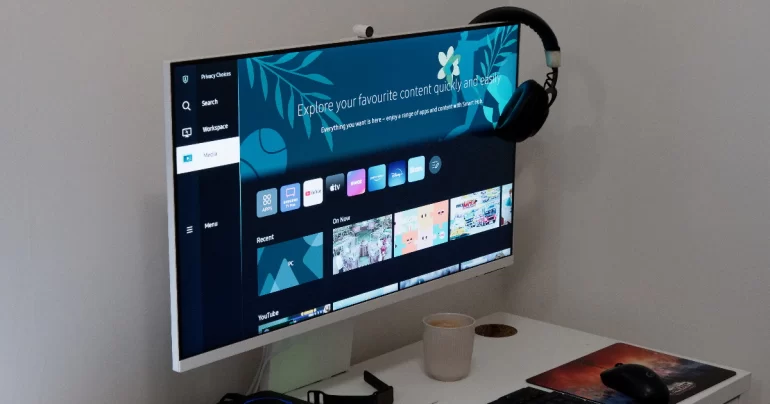The formula it proposes has a profound impact on our experience.
The start-up of this monitor is essentially traced to that of a Samsung television. We have to connect it to our Wi-Fi network and identify ourselves using a user account of this brand if we have one. And a little more. After completing several simple phases, the wizard will give way to the Tizen interface, which, as we have seen above, is very similar to the one offered by this company’s televisions.
The hardware that incorporates this monitor moves this operating system with agility, so I have nothing to object to in this area. In addition, the apps it includes, among those offered by Netflix, Prime Video, Disney +, Apple TV, or YouTube, among others, are fabulous. As in any Samsung TV. However, this screen offers one more feature that can be very attractive in some scenarios.
And it is that it also allows us to remotely access a Windows PC, a Mac, or a Samsung mobile device that incorporates the DeX platform. In this way, we can work without the need to connect a computer to this monitor directly. It is clear that this is not the most frequent use scenario, but it is an option that may fit some users, and there is no doubt that this feature increases the added value of this Smart Monitor M8.
If we take advantage of the remote connection to a computer, we can use a Bluetooth link to link a keyboard and a mouse directly to the monitor. This is all we need to work on. One more note: this screen incorporates the Bixby and Alexa voice assistants, allowing us to use our voice to interact with it and control other devices compatible with these technologies.
Its 60 Hz panel, its response time (4 ms GtG), and the absence of HDMI 2.1 connectivity discourage it from demanding gamers.
If we keep in mind what we have seen so far, we will conclude that this monitor is a work tool. In that case, is it also used to play? Yes, of course, it works, but there are cheaper and more attractive options for gaming. Its panel with a refresh rate of 60 Hz, its response time (4 ms GtG), and the absence of HDMI 2.1 connectivity discourage demanding gamers. However, it seems correct for those who only play occasionally.
Your aesthetic bet is the gateway to a different monitor.
I usually start my reviews of monitors by emphasizing that their real heart is their panel, and this screen is no different. Its 32-inch VA LCD matrix with 4K UHD resolution and a refresh rate of 60 Hz has a very profound impact on its image quality. However, we must not overlook that this is only one of the ingredients in the recipe that Samsung proposes.
If your panel is the heart of this monitor, its operating system is its brain. In the photograph we publish below these lines, we can see that the interface of the version of Tizen that this Smart Monitor M8 offers us is very similar to the one that we can find in the latest generation televisions of this brand. And it is good news because this platform is agile and incorporates most of the currently popular apps.
One point in its favor: its top and side frames are so thin that they go unnoticed at a certain distance.
In any case, as I mentioned a few lines above, the most prominent hallmark of this monitor is its design. Its top and side frames are skinny, so much so that they go unnoticed at a certain distance (it is the same thing that happens with the Infinity design of some televisions of this brand). The lower frame, as usual, is a little thicker, but it’s 16 mm does not blur this screen’s aesthetics.
In the following photograph, we can see that the back of the monitor enclosure is entirely translucent. It is 11 mm thick, and the only protrusion that adds a few more millimeters is the piece that acts as an anchor for the base. Samsung has taken care of the design of the rear panel of this monitor so that it does not clash in those scenarios of use in which it is exposed.
The enclosure confines the VA LCD panel, and the base of this monitor is polycarbonate. It is not a luxurious material, but at least the plastic for which it must be sung to Samsung is good quality. The only metallic element of this screen is the base. It makes sense that it is not made of polycarbonate because it must provide the necessary mass to guarantee that the monitor will remain stable even if we accidentally push it to a certain intensity.
The base incorporates a rail that allows us to adjust the panel’s height to a maximum range of about 12 cm. We can also act on its inclination in the field that extends between -2º and 15º, but we can neither pivot nor rotate it. And I miss these two additional adjustment options because it is likely that some users would have helped them find the optimal setting from an ergonomic point of view. In addition, with its Space Monitor 32″ 4K UHD, Samsung has shown that it knows how to solve the ergonomics of a monitor.
